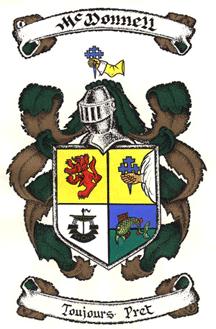by Robert McConnell
Unlike the Scottish McConnells who were forced to abandon their land, the Irish Earls continue to have an estate to this day. Also, while almost all Irish Earls in Ulster abandoned their lands and fled in the first years of 1600, the McDonnells stayed. The 13th Earl of Antrim, a McDonnell, lives in the town of Glenarm in Glenarm Castle. Every 14th and 15th of July there is a meeting of the McDonnell/McConnell Clan in Glenarm and the gate to the castle is opened. The castle's gardens are open to the public year round. I visited the gate of the castle and saw on it a crest divided into four parts, similar to one on the bottom of this page. There is also the same crest displayed at Dunluce Castle, one of the best preserved castles (considering it was abandoned in the 1600s) open to the public in Northern Ireland. Randall McDonnell, the first Earl of Antrim, was the last resident of Dunluce Castle. Dunluce Castle was donated to the government of Northern Ireland by the McDonnell family in the 1930s and it is well worth seeing.
The first Earl of Antrim, Randal McDonnell, was the son of Sorley Boy ("Sorley Boy" was actually Somerled in Gaelic, but the English thought the Gaelic version sounded like Sorley Boy) McDonnell. Randal had always sided with the rebellious Irish Earls of Ulster against the English. However, when James VI of Scotland became James I of England, the McDonnells were suddenly transformed from rebellious outlaws into loyal kinsmen. They were granted all of the Glens and the Route, the whole Antrim coast from the River Bann to Larne, and the entire Antrim plateau. In 1620 Randal was made the first Earl of Antrim in recognition of his close standing with the King. As part of his duties as Earl, Randall was required to build and maintain castles in each of his baronies, so Randal spent time building onto Glenarm Castle and castles in Ballycastle. He also brought in Scottish settlers who were James I's first experiment in preparation for the Plantation of Ireland.
The McDonnells of Antrim were Catholics, but most of the
people who were brought over in the Plantation were Protestant lowland
Scottish settlers. Eventually the differences in religion would cause
major problems in Northern Ireland. The third Earl of Antrim, Alexander
McDonnell, like most of the highland Scots (including the Scottish McConnells),
fought on the side of the pro-Catholic Jacobites and he was the general
who led the Catholic army in its failed siege against Londonderry.
He and his Jacobite army lost, while fighting alongside the dispossessed
King James II, in the Battle of Boyne against William of Orange.
From that time Northern Ireland became permanently Protestant and the Catholics
were a persecuted minority. Alexander McDonnell barely managed to
hold onto his estates after the war. However, the estates have remained
in the McDonnell family to this day and the 13th Earl of Antrim still lives
in Glenarm Castle in the town of Glenarm [which means the Glen of the Army],
the first of nine beautiful, stunningly picturesque, Glens along the coast
of Northern Ireland.
